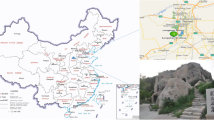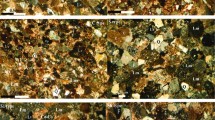Abstract
The aim of the study was to identify and describe changes in two different sandstone types when undergoing different environmental and extreme temperature regimes to assess the possibility of finding insolation weathering and how these sandstones would behave during and after a fire. The first step was the simulation in the laboratory of temperature regimes up to 60 °C which would correspond to extreme events that could be found in insolation cycles even in Central Europe and the second one was the temperature above 200 °C simulating in laboratory conditions the thermal regime of a potential fire situation at temperatures up to 200, 400, 600 and 800 °C. Heating the samples above 400 °C led to gradual changes in mineral composition, colour, surface roughness and physical properties reaching, eventually, total rock breakdown through spalling and granular disaggregation. The different behaviour of sandstones exposed to high temperatures is mainly caused by their different mineral composition with various ratios of minerals that are more or less chemically stable at high temperatures as well as by the differences in the porosity.












Similar content being viewed by others
References
Allison RJ, Goudie AS (1994) The effect of fire on rock weathering: an experimental study. In: Robinson DA, Williams RBG (eds) Rock weathering and landform evolution. Wiley, Chichester, pp 41–56
ASTM E313—Standard Practice for Calculating Yellowness and Whiteness Indices from Instrumentally Measured Color Coordinates
Bartlett WH (1832) Experiments on the expansion and contraction of building stones, by variations of temperature. American Journal of Science 22:136–140. http://books.google.com/books?id=mSZGAAAAcAAJ&source=gbs_navlinks_s. Accessed 17 Feb 2011
Boynton RS (1980) Chemistry and technology of lime and limestone, 2nd edn. Wiley, New York
Chakrabarti B, Yates T, Lewry A (1996) Effect of fire damage on natural stonework in buildings. Constr Build Mater 10:539–544. doi:10.1016/0950-0618(95)00076-3
Cooper HW, Simmons G (1977) The effect of cracks on the thermal expansion of rocks. Earth Planet Sci Lett No 36:404–412. doi:10.1016/0012-821X(77)90065-6
Dionísio A (2007) Stone decay induced by fire on historic buildings: the case of the cloister of Lisbon Cathedral (Portugal). In: Přikryl R, Smith BJ (eds) Building stone decay: from diagnosis to conservation. Geological Society Special Publication 271, London, pp 87–97. doi:10.1144/GSL.SP.2007.271.01.10
Dionísio A, Sequeira Braga M, Waerenborgh J (2009) Clay minerals and iron oxides-oxyhydroxides as fingerprints of firing effects in a limestone monuments. Appl Clay Sci 42:629–638. doi:10.1016/j.clay.2008.05.003
EN 1936 (2006) Natural stone test methods. Determination of real density and apparent density, and of total and open porosity
EN ISO 25178-6 (2010) Geometrical product specifications (GPS)—Surface texture: Areal—Part 6: classification of methods for measuring surface texture (ISO 25178-6:2010)
Farmer VC (1974) The infrared spectra of minerals. Monograph 4. Mineralogical Society of Great Britain and Ireland, London
Galán E (1991) The influence of temperature changes on stone decay. In: Zezza F (ed) Weathering and Air Pollution. First Course. Community of Mediterranean Universities, University School of Monument Conservation, Mario Adda Editore, Bari, pp 119–129
Gillhuber S, Lehrberger G, Goske J (2010) Fire damage of trachyte: investigations of the Teplá monastery building stones. In: Přikryl R, Török Á (eds) Natural stone resources for historical monuments. Geological Society, London, pp 73–80
Gomez-Heras M, Varas MJ, Álvarez de Buergo M, Fort R (2004) Characterization of changes in matrix of sandstones affected by historical fires. In: Kwiatkowski D, Lofvendahl R (eds) 10th International Congress on Deterioration and Conservation of Stones—Stockholm, pp 561–568
Gomez-Heras M, Álvarez de Buergo M, Fort R, Hajpál M, Török A, Varas M (2006a) Evolution of porosity in Hungarian building stones after simulated burning. In: Fort R, Alvarez de Buergo M, Gomez-Heras M, Vazquez-Calvo C (eds) Heritage, Weathering and Conservation. Taylor & Francis, London, pp 513–519
Gomez-Heras M, Figueiredo C, Varas M, Maurício A, Álvarez de Buergo M, Aires-Barros L (2006b) Digital image analysis contribution to the evaluation of the mechanical decay of granitic stones affected by fires. In: Kourkoulis SK (ed) Fracture and failure of natural building stones. Springer, Dordrecht, pp 427–437
Gomez-Heras M, Smith BJ, Fort R (2008a) Influence of surface heterogeneities of building granite on its thermal microenvironment and its potential for the generation of thermal weathering. Environ Geol 56:547–560. doi:10.1007/s00254-006-0538-0
Gomez-Heras M, Fort R, Morcillo M, Molpeceres C, Ocana J (2008b) Laser heating: a minimally invasive technique for studying fire-generated heating in building stone. Materials de Construccion 58:203–217. doi:10.3989/mc.2008.v58.i289-290
Gomez-Heras M, McCabe S, Smith BJ, Fort R (2009) Impacts of fire on stone-built heritage. J Arch Conserv 15(2):47–58
Goudie AS, Allison RJ, McLaren SJ (1992) The relations between modulus of elasticity and temperature in the context of the experimental simulation of rock weathering by fire. Earth Surf Proc Land 17(6):605–615. doi:10.1002/esp.3290170606
Hajpál M (1999) Behaviour of sandstones of historical monuments under thermal influence. Periodica Polytechnical Budapest 43:207–218
Hajpál M (2002) Changes in sandstones of historical monuments exposed to fire or high temperature. Fire Technol 38:373–382. doi:10.1023/A:1020174500861
Hajpál M, Török A (2004) Mineralogical and color changes of quartz sandstones by heat. Environ Geol 46:311–322. doi:10.1007/s00254-004-1034-z
Hall K, Lindgren SB, Jackson P (2005) Rock albedo and monitoring of thermal conditions in respect of weathering: some expected and some unexpected results. Earth Surf Proc Land 30:801–811. doi:10.1002/esp.1189
Hall K, Meiklejohn I, Arocena J (2007) The thermal responses of rock art pigments: implications for rock art weathering in southern Africa. Geomorphology 91:132–145. doi:10.1016/j.geomorph.2007.02.002
Hall K, Meiklejohn I, Summer P, Arocena J (2008) Light penetration into Clarens sandstone and implications for deterioration of San rock art. Geoarcheology 25:122–136. doi:10.1002/gea.20296
Jaeger JC, Zimmerman R, Cook NG, Cook NGW, Zimmerman RW (2007) Fundamentals of rock mechanics, 4th edn. Wiley, Singapore, p 475
Kieslinger A (1954) Brandeinwirkungen auf Natursteine. Schweizer Archiv 9:305–308
Kompaníková Z, Durmeková T, Vlčko J, Brček M, Gomez-Heras M (2011a) Monitoring of travertine changes resulting from thermal load. Acta Geologica Slovaca 3 1:83–94. http://digital.csic.es/handle/10261/62238. Accessed 12 Sep 2013
Kompaníková Z (2011b) The influence of temperature change on physical properties of building and decorative stone. Dissertation, Comenius University in Bratislava
Kristóf-Makó É, Juhász AZ (1999) The effect of mechanical treatment on the crystal structure and thermal decomposition of dolomite. Thermochim Acta 342:105–114. doi:10.1016/S0040-6031(99)00290-7
Logan JM, Hastedt M, Lehnert D, Denton M (1993) A case study of the properties of marble as building veneer. Int J Rock Mech Min Sci Geomech 30:1531–1537. doi:10.1016/0148-9062(93)90152-4
Madejová J, Komadel P (2001) Baseline studies of the clay minerals society source clays: infrared methods. Clays Clay Miner 49(5):410–432. doi:10.1346/CCMN.2001.0490508
McCabe S, Smith BJ, Warke PA (2010a) Exploitation of inherited weakness in fire-damaged building sandstone: the ‘fatiguing’ of ‘shocked’ stone. Eng Geol 115:217–225. doi:10.1016/j.enggeo.2009.06.003
McCabe S, Smith B, Warke P (2010b) A legacy of misttment: conceptualizing the decay of medieval sandstone in NE Ireland. In: Přikryl R, Török A (eds) Natural Stone Resources for Historical Monuments, Special Publication No 33. Geological Society, London, pp 87–100. doi:10.1144/SP333.9
Pettijohn F, Pott P, Siever R (1987) Sand and sandstone. Springer, New York
Ramana YV, Sarma LP (1980) Thermal expansion of a few Indian granitic rocks. Phys Earth Planet Inter 1980(22):36–41. doi:10.1016/0031-9201(80)90098-9
Siegesmund S, Ullemeyer K, Weiss T, Tschegg EK (2000) Physical weathering of marbles caused by anisotropic thermal expansion. Int J Earth Sci 89:170–182. doi:10.1007/s005310050324
Sippel J, Siegesmund S, Weiss T, Nitsch KH, Korzen M (2007) Decay of natural stones caused by fire damage. In: Přikryl R, Smith BJ (eds) Building stone decay: from diagnosis to conservation, vol 271. Geological Society, London, pp 139–151
Smith BJ, Srinivasan S, Gomez-Heras M, Basheer PAM, Viles HA (2008) Experimental studies of near-surface temperature cycling and surface wetting and its implications for salt weathering. In: Ottosen LM, Rorig-Dalgaard I, Larsen PK, Brajer I, Bollingstoft P, Marciniak M, Svane M (eds) Salt weathering on buildings and stone sculptures. Technical University of Denmark, Copenhagen, pp 65–78
Stanmore BR, Gilot P (2005) Review—calcination and carbonation of limestone during thermal cycling for CO2 sequestration. Fuel Process Technol 86:1707–1743. doi:10.1016/j.fuproc.2005.01.023
Török Á, Hajpál M (2005) Effect of Temperature Changes on the Mineralogy and Physical Properties of Sandstones. A Laboratory Study. Restoration of Buildings and Monuments. Bauinstandsetzen un Baudenkmalpflege, Vol. 11, No 4:1–8. http://www.epito.bme.hu/eat/dolgozok/feltoltesek/toroka/torok_hajpal_int_jour_restoration_2005.pdf
Vlcko J, Greif V, Holzer R, Hencelova L, Jezny M (2007) Rock Deformation Monitoring at Cultural Heritage Sites in Slovakia. In: Sassa K, Fukuoka H, Wang F, Wang G (eds) Progress in Landslide Science. Springer, Berlin, pp 261–273
Vlcko J, Kompaníková Z, Gomez-Heras M, Durmekova T, Greif V, Brcek M (2012) Surface roughness change on sandstone induced by temperature increase. Geophysical Res Abstracts, vol 14, EGU 2012-4703. http://meetingorganizer.copernicus.org/EGU2012/EGU2012-4703.pdf. Accessed 12 Sep 2013
Winkler EM (1997) Stone in Architecture. Properties, Durability. Springer, Berlin
Acknowledgments
This work was supported by the Slovak Research and Development Agency under the contracts No. APVV-0641-10 and No. APVV VVCE-0033-07 and by the Geomateriales program (S2009/MAT-1629) of the Madrid Regional Government. The authors are thankful the Petrophysics laboratory of the Institute of Geosciences (CSIC-UCM) in Madrid where fire-decay tests were carried out as well as the Institute of Inorganic Chemistry of Slovak Academy of Sciences in Bratislava where analysis and interpretation of IR spectra were performed.
Author information
Authors and Affiliations
Corresponding author
Rights and permissions
About this article
Cite this article
Kompaníková, Z., Gomez-Heras, M., Michňová, J. et al. Sandstone alterations triggered by fire-related temperatures. Environ Earth Sci 72, 2569–2581 (2014). https://doi.org/10.1007/s12665-014-3164-2
Received:
Accepted:
Published:
Issue Date:
DOI: https://doi.org/10.1007/s12665-014-3164-2




